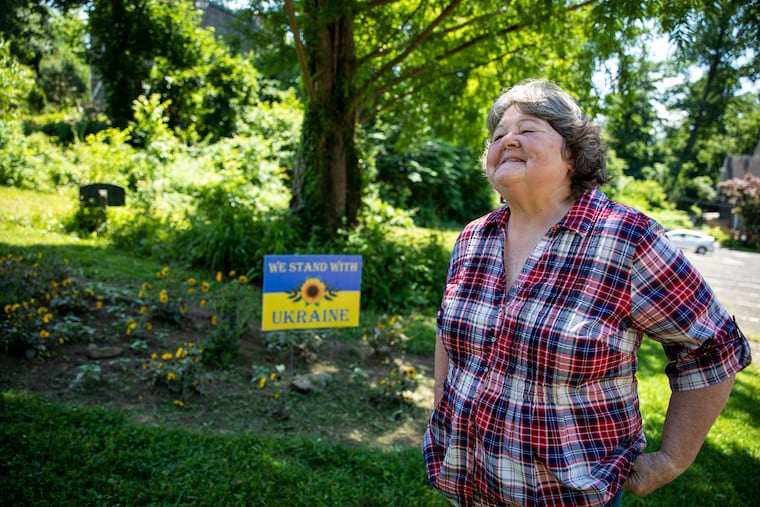A smaller show of Philly flowers, to support a Ukraine under siege
Church members wanted their support for Ukraine to bloom in flowers, so they bought plants, rented a tiller, and set to work

Few people will see this particular flower show, a small garden on the edge of a church parking lot in West Mount Airy.
But that doesn’t make it any less meaningful to those who turned the earth and set the seeds.
They chose a single type of flower, the sunflower, the national flower of Ukraine, planted in prayer and support of a country under attack — and now blooming in bright bursts of brown and yellow.
“It means ‘hope’ to me,” said Mary Kalyna, a church member of Ukrainian heritage who helped start the garden this spring. “Anytime you plant something, it’s a sign of hope.”
Only those visiting the Unitarian Society of Germantown, or walking its grounds, would notice the bed. The church isn’t Ukrainian, formed from Universalists and Unitarians who welcome all faiths, ethnicities, and sexual orientations. It has only one or two Ukrainian Americans, including Kalyna, among its 300 members.
But when Russia invaded on Feb. 24, Kalyna spoke to her fellow congregants about the violence against Ukraine. Church members began to educate themselves — and to take action.
They started a regular Friday evening vigil for Ukraine, gathering with signs on the sidewalk and cheering the honks of passing motorists. They hung a blue-and-yellow banner that says “We stand with Ukraine” at the front door. The choir learned and performed the Ukrainian national anthem — and a new song, “A Ukrainian Prayer,” by English composer John Rutter.
“We had to be speaking out with those around the world,” said the Rev. Kent Matthies.
As spring arrived, people wanted their support to grow. Last month they bought bunches of young plants and rented a tiller, grabbed some shovels, called on children in the church to help dig and plant and water.
By last week the sunflowers were knee-high.
“They’re really coming up now,” said church member Janet Haas, a gardener who has taken on the role of sunflower chief.
She and the others deliberately chose small sunflowers — some grow 15 feet or higher — because tall ones could block drivers’ views as they parked.
Big flower or small, the message was the same.
“Solidarity,” Haas said, voicing her ache for the people of Ukraine. “‘We’re thinking of you, every time we pass here.’”
The sunflower mimics the colors of the Ukrainian flag, yellow plant against blue sky. It’s integral to Ukrainian culture, its image embroidered onto clothing and carved and painted on furniture.
It’s also a major cash crop. Ukraine, slightly smaller than Texas, is the top world exporter of sunflower and safflower oil, commanding more than half the market.
Ukraine controls 52.2% of all oil exports, with Russia second at 20.2%, according to the Observatory of Economic Complexity. Ukrainian exports totaled $4.7 billion in 2020, compared to Russia’s $1.8 billion.
The plant — Helianthus annuus — is nothing short of remarkable.
It can be eaten, used to cook, turned into lubricants. Its leaves are fodder for livestock, its petals a source of yellow dye, its oil tapped in restaurants and kitchens — and for paints and soaps. Birds and baseball players gobble its seeds.
Scientists use sunflowers to suck radioactivity from the ground after nuclear disasters. The plant is what’s called a “hyperaccumulator,” meaning it can extract large amounts of toxins from soil, and was pressed into service in Chernobyl in 1986 and Fukushima in 2011.
The sunflower is grown in more than 80 countries. It’s the state flower of Kansas, which nonetheless trails far behind North Dakota and South Dakota in growing. Those two states account for 84% of sunflower production in the U.S.
Since the war started, Ukrainian farming and shipping have become nearly impossible, and oilseed facilities have mostly suspended operations. That’s driven worldwide price increases for sunflower oil and for foods that include it.
At the same time, the war has made the sunflower the international, instantly recognizable symbol of Ukrainian resistance, blooming on billboards, flags, and posters. Demonstrators laid sunflowers at the gates of Russian embassies in Washington, London, and Madrid.
Despite that close association, the sunflower isn’t native to Ukraine. It was grown by Indigenous peoples in North America more than 4,500 years ago, according to research by the National Sunflower Association and by Nuseed, a California-based sunflower company.
Native Americans milled the crop into flour, while seeds were roasted or mixed with grains and nuts for meals.
European explorers discovered the sunflower in about 1510, the Spanish the first to carry home large quantities of seeds. For two centuries Europeans overlooked the plant’s food and oil potential, its beauty driving its spread across the continent and then into Russia and Ukraine.
The use of sunflower oil expanded in part and unintentionally because of the Russian Orthodox Church. In the 18th century the church banned consumption of certain oils during Lent. Somehow, sunflower oil was left off the list. People bought it and liked it.
By the early 1800s, sunflower crops covered nearly 2 million acres in Russia and Ukraine.
The Universalist Unitarian church garden is infinitely smaller, about 20 feet long and eight feet wide. But it offers its own vibrancy.
“We’re committed to tending it,” Matthies said. “People are holding beauty as a way of holding solidarity with Ukraine.”
Gardens are living things, he noted, and they need care and attention, just like people. Kalyna, the daughter of Ukrainian immigrants, is among those committed to keeping their small garden healthy and well.
“It’s something that really symbolizes the church’s support for the people in Ukraine,” she said. “I feel so proud of my church.”